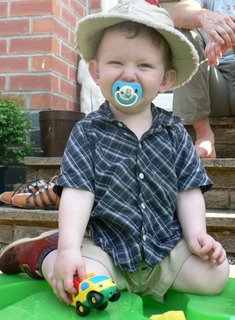Polite enquiry and emailing has revealed that unilateral implantation is policy, one shared with a conglomeration of PCTs who 'share the risk' of members of their collective populations being in need of cochlear implants. The discussion was short and polite; the dismissal clearly intended, on their part, to be the end of the matter. We don't share that view.
The history bit...
Cochlear implants have not been around particularly long (the FDA approved the first device in 1984 and lowered the approved age for implantation to two in 1990) and the UK can't be said to have been at the forefront of their development although Nottingham started the first dedicated paediatric program around that time, albeit with very strict criteria. Indeed, if you look at some policies that are still floating around on the web such as this little beauty you will see that some areas regard the restoration of a sense vital for communication with the majority of the population as on a par with alternative therapies and extraction of wisdom teeth and only slightly more worthy of funding than penile implants and hair removal. Luckily, our commissioning region had the foresight to accept the clinical evidence and fund the implants as long ago as 2003.
So just as the UK is catching up, those clever folks in the USA and Germany amongst others start moving the goalposts and exploring bilateral implantation. Double the initial cost, for sure but the question that hangs over it is whether its double the effectiveness. What does the restoration of binaural hearing (hearing with both ears) give you that only restoring some hearing in one ear does not?
The science bit...
It seems obvious to most people that you can hear better with two ears than you can with one. Putting the scientific gloss on this, it gives you:
- Better localisation. Sound will reach your ears at slightly different points in time unless its source is directly in front or behind you. This difference allows the brain to work out much more easily where the sound came from.
- Improved hearing for speech in noise. The reasons for this are complex and well explained in this rationale for bilateral implantation and include the impact of the head shadow (if the source of the sound is close to you on your non-hearing side your hearing side is in an acoustic 'shadow') and the squelch effect - your brain's ability to pick out speech when the sound received in each ear has a different signal-to-noise ratio.
- Safety.
- Redundancy. The implant is an artificial device - a very well designed, reliable one but still susceptible to failure. With only one, failure casts the user back into their silent world for however long it takes to repair.
Straightforward you would think? Alas, no. These are expensive pieces of kit and implantation leads to a life-time support commitment in addition to the initial outlay. It is at this point where our marvellous 'free at the point of delivery' National Health Service starts to creak a little. This is a service that saved my son's life and arranged the first implantation in 'speeding bullet' time so I am not about to launch into any sort of condemnation. But...
The body of research material is growing - unfortunately, for every article that supports our case such as this American study by Dr. Ruth Litovsky or this recent study , there is something like this cost-utility scenario analysis which funding bodies leap on with obvious relish. The cost-effectiveness of the procedure is what counts and, although there is more than one way to do the calculation, the funders can still cherrypick research that suits their budgetary constraints.
The issue that keeps me awake though, as I described in Pictures of Cochlea, is that post-meningitic children have cochlea that are prone to ossification and we don't have time to wait. As the British Cochlear Implant Group note and the National Deaf Children's Society reiterate:
... that there may be clinical reasons when professionals would consider bilaterally fitting a child. In particular, this could be following meningitis where there might be particular issues relating to ossification. This could mean that to not bilaterally fit a child, should the need arise to reimplant, for whatever reason (device failure,
breakdown of the original implant site, displacement following trauma, etc) then
the rapid ossification might mean that to reimplant in the other ear would not
be feasible.
This is the sort of thing that leads to sitting in front of your MP at his constituency surgery and doing your best to cut through the scientific blurb to the soundbite that would stick in their minds. I came away thinking we'd managed it so lets see....


